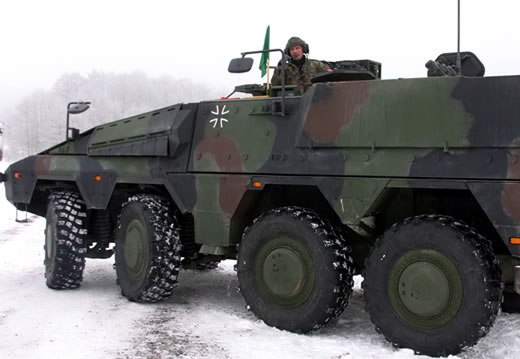
The first Boxer armored personnel carriers (Gepanzertes Transport-Kraftfahrzeug – GTK) have arrived at Donaueschingen Germany in February 2011 to equip the 292 Jägerbattalion (light infantry battalion), in preparation for the unit’s deployment to Afghanistan by August this year. The battalion will dispatch a platoon with four vehicles to be deployed to Mazar-e-Sharif in Northern Afghanistan, as part of the German training and protection battalion. Last year the Boxer went through a successful operational evaluation in Australia, which paved the way for the deployment decision.

According to infantry officers training with the vehicles, the first experience with the Boxer is positive with the vehicle described as ‘robust, impressive and offering a high level of protection and mobility’. Driver orientation courses are currently underway at the driver training school in Dornstadt, where seven Driver Training Vehicles (DTV) were received in 2010.
The 292 Jägerbattalion is receiving the infantry carries, each carrying seven troops in addition to three crew members – the driver, gunner and Commander. Eight of the vehicles have been delivered to the Infantry school to start the infantry training with the unit. The unit holds a daily evaluation of the training activities to further improve training, deliver operational feedback, and report technical and operational issues to the program office, vehicle developer and industry on technical problems.

The Boxer offers high level of safety and relative comfort to the occupants. Troops are seated in individual blast protected seats, while crew members are provided with adjustable blast protected seats designed for each position. An air conditioner which also supports Chemical, Biological and Radiological-Nuclear (CBRN) filtration is also provided. Water heater and toilet facility make a long stay in the vehicle more comfortable.
The power pack consists of a militarized MTU model 8V199 TE20 diesel developing 530 kW coupled with Allison model HD4070 fully automatic transmission with seven forward and three reverse gears, torque converter and an integrated cooling. The drive train features selectable differential locks and two steerable front axles. The tires are equipped with run flat, and with central tire inflating system adapting the tire pressure to optimally traverse difficult terrain (sand, snow, mud etc). Independent suspension allows both speeding on roads and high mobility off-road. The vehicle has a passive protection system comprising modular base armor and applique composite modules. The FLW 200 Remotely controlled light weapon station provides the primary weapon for the Boxer, controlled by the gunner from inside the vehicle. The station mounts a 12.7 or 40mm automatic grenade launcher.




















